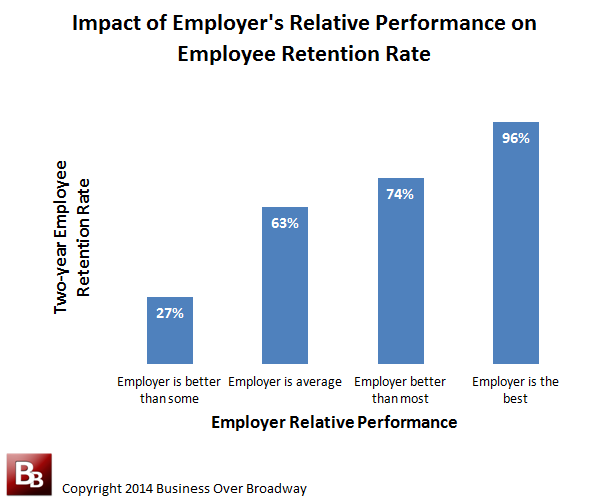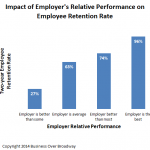Last week, I compared two employee turnover metrics. One metric was a self-reported measure gathered through surveys. The other metric reflected the employment status at a later date (the objective metric). The analysis showed that, while self-reported intentions to quit predicted whether or not the employee actually quit, the correlation between the two metrics was only r = .31. Are there other, better predictors of actual employee turnover? In this week’s post, I dive deeper into that study’s data to show the predictive power of another self-reported metric.
The Power of Relative Performance
In the aforementioned study, we have a few other employee survey questions that might help us better predict employee turnover:
- Overall employee satisfaction: Overall, how satisfied are you with company name as an employer? (0-Extremely dissatisfied to 10-Extremely satisfied)
- Likelihood to recommend employer: How likely are you to recommend company name to your friends as a place to work? (0-not at all likely to 10-Extremely likely)
- Relative performance: How does company name compare as an employer to other companies where you have worked? (0-Worst to 100-Best)
Using the 2-year turnover behavior as the outcome variable, I found that, compared to all other questions, relative performance (r = .41), was the best predictor of employment status two years later. The other employee loyalty metrics were less predictive of employment status two years later (Overall satisfaction: r = .27; Likelihood to recommend: r = .36; Likelihood to quit: r = .31). As you can see in Figure 1, employee retention was strongly related to how the employee compared the employer to past employers. Employees who believe they are working for the best employer have a two-year retention rate of 96%. On the other hand, employees who believe they are working for an average (or worse than average) employer are more likely to be gone in two years (retention rate of 63% and 27%).

Figure 1. Your relative performance is important. How your employees compare you to previous employers was the best predictor of real employee turnover behavior.
Summary and Conclusions
In the current study, the best predictor of employee turnover two years later was not the employee’s intention to quit, but, rather, how the employee compared you to previous employers.
Knowing how your employees feel about you relative to former employers can help you accurately estimate future levels of employee retention (helping in resource planning). For example, of employees who felt the employer was the best, over 90% of them were around two years later. Of employees who felt the employer was better than some, only about 30% of them will be around two years later. Understanding the reasons why employers rank you high or low would be a good start at understanding how to improve employee retention.
How your employees compare you to previous employers is the top early warning indicator of employment status two years later, more so than employees’ stated intention of leaving. In your employee survey, consider asking your employees to compare you to other employers. It could give you some useful insight about your future employee turnover rate as well as identifying ways to best decrease employee churn.




 Beyond the Ultimate Question
Beyond the Ultimate Question Measuring Customer Satisfaction and Loyalty (3rd Ed.)
Measuring Customer Satisfaction and Loyalty (3rd Ed.)
[…] won’t make even a small investment in training, but would rather pay through the nose in employee turnover. There’s that mindset […]
[…] and number of employees that are looking for a job. If there are more jobs available, than the employee turnover rate is higher, since people are trying to get the better job. The Maslow’s Hierarchy of […]
[…] is a whopping 50%, enough to make employers lose sleep over the tangible and intangible costs of employee turnover. Turnover has an immediate effect, particularly in customer service-dependent areas of the […]
[…] Your Relative Performance: A Better Predictor of Employee Turnover: The best predictor of actual employee turnover (from an employee survey taken 2 years prior) is how your employees compare you to prior employers. For employee who think you’re only average or worse than most previous employers, their retention rate two years later is only 45%. For employees who think you’re better than most or the best compared to prior employers, their two year retention rate is 85%. […]